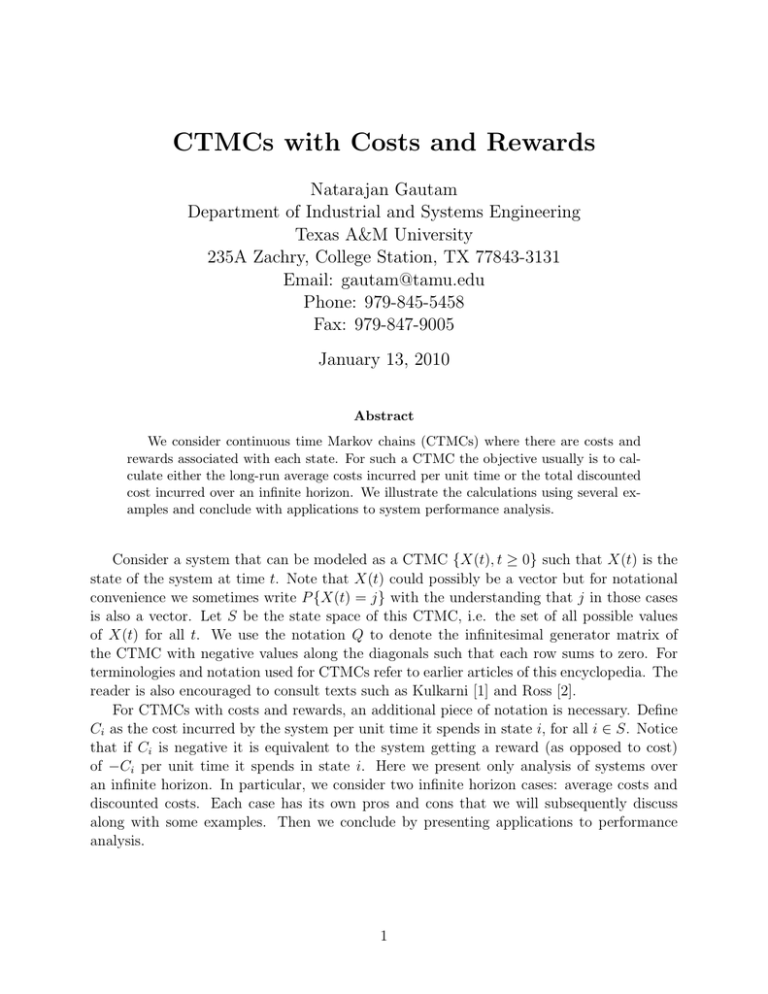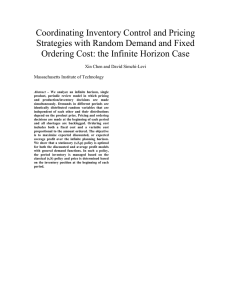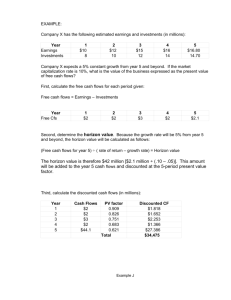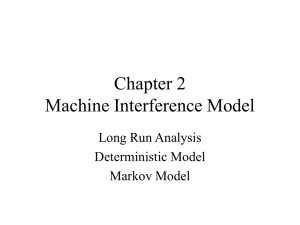CTMCs with Costs and Rewards
advertisement

CTMCs with Costs and Rewards
Natarajan Gautam
Department of Industrial and Systems Engineering
Texas A&M University
235A Zachry, College Station, TX 77843-3131
Email: gautam@tamu.edu
Phone: 979-845-5458
Fax: 979-847-9005
January 13, 2010
Abstract
We consider continuous time Markov chains (CTMCs) where there are costs and
rewards associated with each state. For such a CTMC the objective usually is to calculate either the long-run average costs incurred per unit time or the total discounted
cost incurred over an infinite horizon. We illustrate the calculations using several examples and conclude with applications to system performance analysis.
Consider a system that can be modeled as a CTMC {X(t), t ≥ 0} such that X(t) is the
state of the system at time t. Note that X(t) could possibly be a vector but for notational
convenience we sometimes write P {X(t) = j} with the understanding that j in those cases
is also a vector. Let S be the state space of this CTMC, i.e. the set of all possible values
of X(t) for all t. We use the notation Q to denote the infinitesimal generator matrix of
the CTMC with negative values along the diagonals such that each row sums to zero. For
terminologies and notation used for CTMCs refer to earlier articles of this encyclopedia. The
reader is also encouraged to consult texts such as Kulkarni [1] and Ross [2].
For CTMCs with costs and rewards, an additional piece of notation is necessary. Define
Ci as the cost incurred by the system per unit time it spends in state i, for all i ∈ S. Notice
that if Ci is negative it is equivalent to the system getting a reward (as opposed to cost)
of −Ci per unit time it spends in state i. Here we present only analysis of systems over
an infinite horizon. In particular, we consider two infinite horizon cases: average costs and
discounted costs. Each case has its own pros and cons that we will subsequently discuss
along with some examples. Then we conclude by presenting applications to performance
analysis.
1
Average Costs Case
The objective here is to obtain an expression for the long-run average cost per unit time
incurred by the system. For this we need some additional assumptions and notation. Recall
that we consider a CTMC {X(t), t ≥ 0} with state space S, infinitesimal generator matrix Q
and costs Ci per unit time the system is in state i for all i ∈ S. We assume that this CTMC
is irreducible and positive recurrent (together it is also known as ergodic) with steady-state
probabilities pj , i.e.
pj = lim P {X(t) = j}.
t→∞
The pj values can be computed by solving for pQ = 0 and i∈S pi = 1, where p is a row
vector of pj values.
It is important to notice that for ergodic CTMCs, the steady state probabilities pj have
two other meanings. First, pj is also the long-run fraction of time the system is in state j,
i.e.
RT
I(X(t) = j)dt
pj = lim 0
,
(1)
T →∞
T
where I(·) is an indicator function such that I(X(t) = j) = 1 if X(t) is j at time t and
I(X(t) = j) = 0 otherwise. Another definition of pj is that it is the stationary probability
that the CTMC is in state j. That means if the initial state of the CTMC is selected
according to pj , i.e. P {X(0) = j} = pj , then at any time t the CTMC would be in state j
with probability pj , i.e. P {X(t) = j} = pj for all t ≥ 0. Thus the system is considered to
be stationary at all t ≥ 0. Now we are in a position to develop an expression for the long
run average cost per unit time for this system.
Let C be the long-run average cost incurred by the system per unit time. By definition,
since C is time-averaged, it can be written as
P
RT
0
C = lim
T →∞
CX(t) dt
.
T
We can rewrite the right hand side of the above expression using a sum to get
RT X
0
C = lim
Ci I(X(t) = i)dt
i∈S
T →∞
T
.
Since the CTMC is positive recurrent, we are allowed to write the above expression as
C=
X
i∈S
lim
T →∞
RT
0
Ci I(X(t) = i)dt
.
T
Using the definition of pi in Equation (1) and substituting, we get
C=
X
i∈S
2
Ci pi .
(2)
Discounted Costs Case
Here we consider the case where the costs incurred by the system are discounted at rate α.
By definition that means if the system incurs a cost $ d at time t, its present value at time
0 is de−αt . In other words, it is as though a cost of de−αt is incurred at time 0. We call
α as the discount factor and it is positive in sign. Having defined the discounted cost, we
are ready to develop an expression for the expected total discounted cost over an infinite
horizon. Let Dc be the total discounted cost (note this is a random variable) over an infinite
horizon incurred by the system. Therefore we have by definition
Z
Dc =
∞
CX(t) e−αt dt.
0
Our objective is to obtain E[Dc ]. For this we require two notations. Let ai be the initial
probability the CTMC is in state i, i.e.
ai = P {X(0) = i}.
Notice that if the initial state of the CTMC is known, say j, then aj = 1 and all other ai ’s
would be 0. Also let di denote the expected total discounted cost incurred over the infinite
horizon starting in state i, i.e.
di = E[Dc |X(0) = i].
Thus we have
E[Dc ] =
X
E[Dc |X(0) = i]P {X(0) = i} =
i∈S
X
di ai .
i∈S
Note that E[Dc ] depends on the initial conditions via the ai values. Thus we need to be
given ai , and assuming we have that, next we show how to compute di for all i ∈ S. Based
on the definition we have
di = E[Dc |X(0) = i]
= E
=
Z
0
Z
∞
0
CX(t) e−αt dt|X(0) = i
∞
e−αt
X
Cj P {X(t) = j|X(0) = i}dt
j∈S
provided Cj is bounded. Using the column vector d with elements di such that d = [di ] we
can write down a matrix relation
d=
Z
∞
−αt
e
0
P (t)dt C
where C is a column vector of Cj values and P (t) is a matrix of P {X(t) = j|X(0) = i} for
all i ∈ S and j ∈ S. Using the Laplace Stieltjes Transform (LST) notation for P (t) we get
P̃ (s) =
Z
0
∞
e−st P (t)dt.
3
Thus
d = P̃ (α)C.
However, since P (t) satisfies dPdt(t) = P (t)Q, by taking the LST we get sP̃ (s)−P (0) = P̃ (s)Q.
Using the fact that P (0) = I and solving for P̃ (s) we get
P̃ (s) = (sI − Q)−1 .
Therefore we have
d = (αI − Q)−1 C.
Notice that the matrix αI − Q is invertible for any α > 0. Thus we can compute di and
hence E[Dc ].
Discussion and Examples
It is worthwhile to contrast the discounted costs against the average costs. In the discounted
cost case, the CTMC does not have to be ergodic (it could be reducible or irreducible,
transient or recurrent). However, the average cost results presented require the CTMC to be
ergodic, although there are ways to deal with some non-ergodic cases. One of the demerits of
the discounted cost case is that the results depend on the initial conditions, unlike the average
cost case. Also the discount factor in many practical situations are hard to determine. Next
we present one example for discount cost and one for average cost.
Example 1 Consider a machine that toggles between being under working condition and
under repair. The machine stays working for an exponential amount of time with mean
1/γ hours and then breaks down. A repair-person arrived instantaneously and spends an
exponential amount of time with mean 1/β hours to repair the machine. A revenue of $ r
per hour is obtained when the machine is working and the repair-person charges $ b per hour.
Let X(t) be the state of the machine at time t. Therefore if X(t) = 0, then the machine
is under repair at time t. Also if X(t) = 1, the machine is up at time t. The state space
S = {0, 1}. The generator matrix is
Q=
"
−β β
γ −γ
#
.
Consider the discount cost case with discount factor α and given initial probabilities a0 =
P {X(0) = 0} and a1 = P {X(0) = 1} = 1 − a0 . In fact we could assume that at time 0 the
machine could be up or down (i.e. a0 is 0 or 1 respectively). We seek to obtain an expression
for E[Dc ], the expected total discounted cost over an infinite horizon incurred by the system
in terms of α, a0 , a1 , b, r, β and γ.
Using the discounted cost results we have
E[Dc ] = E[Dc |X(0) = 0]P {X(0) = 0} + E[Dc |X(0) = 1]P {X(0) = 1} = d0 a0 + d1 a1
4
where
"
d0
d1
#
= (αI − Q)−1
"
b
−r
#
=
b(α+γ)−rβ
α(α+γ+β)
bγ−r(α+β)
α(α+γ+β)
.
Notice that the notations used in the discounted costs derivation d and C are d = [d0 d1 ]′
and C = [b − r]′ . The expected total discounted cost over an infinite horizon incurred by
the system is therefore
E[Dc ] = d0 a0 + d1 a1 =
bγ − rβ + (ba0 − ra1 )α
.
α(α + γ + β)
Example 2 Consider two independent and identical machines each with up times and repair
times as described in Example 1. There is only one repair-person who repairs the machines
in the order they failed.
For this example we seek to obtain the long-run average cost per hour incurred by the
system. Recall that this is denoted by C which can be obtained using Equation (2). Let
X(t) be the number of working machines at time t. The state space S = {0, 1, 2}. The
generator matrix is
−β
β
0
Q = γ −β − γ β .
0
2γ
−2γ
The steady-state probabilities p0 , p1 and p2 can be obtained by solving for [p0 p1 p2 ]Q =
2γ 2
2γβ
β2
[0 0 0] and p0 + p1 + p2 = 1 as p0 = 2γ 2 +2γβ+β
2 , p1 = 2γ 2 +2γβ+β 2 , and p2 = 2γ 2 +2γβ+β 2 . Also
notice that C0 = b, C1 = b − r and C2 = −2r. Therefore the long-run average cost per hour
incurred by the system using Equation (2) is
C=
2(γb − βr)(γ + β)
.
2γ 2 + 2γβ + β 2
Performance Evaluation
Here we only consider the average costs case. An important realization to make is that
the costs Ci do not have to be dollar costs. They are just the rates at which something is
incurred when the source is in state i or even any time-averaged measure that depends on
the sojourn time in state i. This is extremely useful in performance analysis and evaluation
of systems. We illustrate that using examples.
Example 3 Consider a telephone switch that can handle at most N calls simultaneously.
Assume that calls arrive according to a Poisson process with parameter λ to the switch.
Any call arriving when there are N other calls in progress receives a busy signal (and hence
rejected). Each accepted call lasts for an exponential amount of time with mean 1/µ amount
of time.
5
Let X(t) be the number of on-going calls in the switch at time t. Clearly, the state space
is S = {0, 1, . . . , N }. The infinitesimal generator matrix is
Q=
−λ
λ
0
0
µ −(λ + µ)
λ
0
0
2µ
−(λ + 2µ) λ
..
..
..
..
.
.
.
.
0
0
0
...
...
...
...
...
0
0
0
..
.
N µ −N µ
.
Now, let (p0 , p1 , . . . , pN ) be the solution to [p0 p1 . . . pN ]Q = [0 0 . . . 0] and p0 + p1 + . . . +
pN = 1. We do not write down the expression for pi but assume that this can easily be done
by the reader.
Say we are interested in finding out the rate of call rejection. Then we have CN = λ
(since in state N calls are rejected at rate λ per unit time) and Ci = 0 for i = 0, 1, . . . , N − 1
(since no calls are rejected when there are less than N in system). Therefore the long-run
average number of calls rejected per unit time is
long-run time-averaged number of lines utilized as
N
X
i=0
N
X
Ci pi = λpN . We can also obtain the
ipi .
i=0
Example 4 The unslotted aloha protocol for multi-access communication works as follows.
Consider a system where messages arrive according to a Poisson process with parameter λ.
As soon as a message arrives, it attempts transmission. The message transmission times are
exponentially distributed with mean 1/µ units of time. If no other message tries to transmit
during the transmission time of this message, the transmission is successful. If any other
message tries to transmit during this transmission, a collision results and all transmissions
are terminated instantly. All messages involved in a collision are called backlogged and are
forced to retransmit. All backlogged messages wait for an exponential amount of time (with
mean 1/θ) before starting retransmission.
Let X(t) denote the number of backlogged messages at time t and Y (t) be a binary
variable that denotes whether or not a message is under transmission at time t. Then the
process {(X(t), Y (t)), t ≥ 0} is a CTMC. Let p = (p00 , p01 , p10 , p11 , p20 , p21 , . . .) be the steadyP
state probabilities, i.e. the solution to pQ = 0 and i,j pij = 1. Say, we are interested in
obtaining the system throughput, i.e. the average number of successful transmissions per
unit time. The rate of successful transmission is µ whenever Y (t) is 1 and zero when Y (t)
is 0. Also when Y (t) is 1, it is not necessary that a transmission would occur, that happens
only with probability µ/(µ + iθ + λ) when X(t) is i. Therefore the throughput can be
computed as
∞
X
pi1 µ2 /(µ + iθ + λ). Interestingly, there is a much simpler way to obtain the
i=0
throughput. If the system is stable, then in steady state the throughput must indeed be λ,
using a conservation of flow argument. To obtain the time-averaged number of backlogged
messages we can compute
∞
X
i(pi0 + pi1 ).
i=0
6
References
[1] V.G. Kulkarni. Modeling and Analysis of Stochastic Systems. Texts in Statistical Science
Series. Chapman and Hall, Ltd., London, 1995.
[2] S.M. Ross. Introduction to Probability Models. Academic Press, San Diego, CA, 2003.
7





